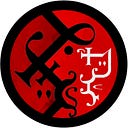Getaberan, the Capital City of Anapt
Getaberan is the capital city of Anapat and, in some way, it is the real capital of all the Beasts’ Nation. It rivals the other metropolises of the world in size, population, and beauty. To be honest, the beauty part is open to debate: Getaberan has no monumental ambition or aesthetic planning, as it grew organically and untamed following its needs and wants.
The Old City is on a hill overviewing the estuary where the river Hosk’y meets the Mermaid Sea. The dense citadel, with narrow streets spiraling upward between packed buildings, is the hinge connecting the two sides of the city.
The Sea Side, going south, deals with all activity related to the open waters: the international harbor, the fish markets, the leviathan hunter’s bases, and so on.
The Riverside pertains to every coming from the Hosk’y: establishments receiving and processing goods from other beasts’ nations, like dockyards, granaries, and spinning mills.
Between these two “wings”, there is the New City, a patchwork of urbanistic ideas, where the Kings and Queens left their mark in different eras. A radial planimetry suddenly stops in favor of an orthogonal grid that tangles up in more eccentric patterns. Each ancestry puts its spin on the already eclectic architecture, like the interconnected towers of the Crowfolk or the tubular passages of the Nagas. There aren’t any “ethnic” neighborhoods, but nepotism created some cluster of people and professions: there is Doily Alley full of felinar seamstresses, Glided Street home of Naga jewelers, Hatchet Road hosting Minotaur carpenters, and the Kenku apothecary of Spice Square.
There are some impressive buildings, the Royal Palace and the House of the Great Council, but the main feature is the big Inner Forest (Argelots’), a vast garden full of trees and barely kept, a piece of nature in the middle of the city. This place is sacred: here the Prophetess of the Spirts’ Way began her preaching after returning from her voyages and it has been preserved as it was 400 years ago. The only buildings are eight golden pagodas, places of pilgrimage and devotion. The Inner forest is also the city cemetery: the followers of the Spirts’ Ways are among the few people who don’t burn their dead and instead bury them. A priest will tell you where to bury your departed, You can mark the grave as you wish, but it must be something perishable, usually wood. If the marking rots away, it’s eaten or you can’t find it anymore, it’s a sign you are ready to move on.
